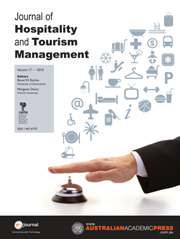Crossref Citations
This article has been cited by the following publications. This list is generated based on data provided by
Crossref.
Lemelin, Raynald Harvey
Johnston, Margaret E.
Dawson, Jackie
Stewart, Emma S.
and
Mattina, Charles
2012.
From hunting and fishing to cultural tourism and ecotourism: examining the transitioning tourism industry in Nunavik.
The Polar Journal,
Vol. 2,
Issue. 1,
p.
39.
Tommasini, Daniela
2012.
Introduction: le tourisme dans l’Arctique.
Études/Inuit/Studies,
Vol. 36,
Issue. 2,
p.
5.
Kaján, Eva
and
Saarinen, Jarkko
2013.
Tourism, climate change and adaptation: a review.
Current Issues in Tourism,
Vol. 16,
Issue. 2,
p.
167.
Larsen, Svein
Wolff, Katharina
Marnburg, Einar
and
Øgaard, Torvald
2013.
Belly full, purse closed.
Tourism Management Perspectives,
Vol. 6,
Issue. ,
p.
142.
Tommasini, Daniela
2013.
Tourisme de croisière et communautés éloignées au Groenland.
Études/Inuit/Studies,
Vol. 36,
Issue. 2,
p.
125.
Stewart, E.J.
Dawson, J.
Howell, S.E.L.
Johnston, M.E.
Pearce, T.
and
Lemelin, H.
2013.
Local-level responses to sea ice change and cruise tourism in Arctic Canada's Northwest Passage.
Polar Geography,
Vol. 36,
Issue. 1-2,
p.
142.
Grimwood, Bryan S.R.
Yudina, Olga
Muldoon, Meghan
and
Qiu, Ji
2015.
Responsibility in tourism: A discursive analysis.
Annals of Tourism Research,
Vol. 50,
Issue. ,
p.
22.
Stewart, Emma
Dawson, Jackie
and
Johnston, Margaret
2015.
Risks and opportunities associated with change in the cruise tourism sector: community perspectives from Arctic Canada.
The Polar Journal,
Vol. 5,
Issue. 2,
p.
403.
Wilson, Jude
Shone, Michael C.
Simmons, David G.
and
Stewart, Emma
2015.
Making Waves: Examining the Interface Between Cruise Tourism and Destination Community in Akaroa, New Zealand.
Tourism in Marine Environments,
Vol. 10,
Issue. 3,
p.
211.
Sookyoung Kang
2016.
A Contents analysis on North - East Asia Cruise Tourism and Resident’s Perception - Focused on Jeju Island -.
FoodService Industry Journal,
Vol. 12,
Issue. 4,
p.
181.
Monterrubio, Carlos
2016.
The impact of spring break behaviour: An integrated threat theory analysis of residents' prejudice.
Tourism Management,
Vol. 54,
Issue. ,
p.
418.
McCauley, Darren
Heffron, Raphael
Pavlenko, Maria
Rehner, Robert
and
Holmes, Ryan
2016.
Energy justice in the Arctic: Implications for energy infrastructural development in the Arctic.
Energy Research & Social Science,
Vol. 16,
Issue. ,
p.
141.
Dawson, Jackie
Johnston, Margaret
and
Stewart, Emma
2017.
The unintended consequences of regulatory complexity: The case of cruise tourism in Arctic Canada.
Marine Policy,
Vol. 76,
Issue. ,
p.
71.
Stewart, Emma J.
Liggett, Daniela
and
Dawson, Jackie
2017.
The evolution of polar tourism scholarship: research themes, networks and agendas.
Polar Geography,
Vol. 40,
Issue. 1,
p.
59.
Cusano, Maria Ines
Ferrari, Claudio
and
Tei, Alessio
2017.
Port hierarchy and concentration: Insights from the Mediterranean cruise market.
International Journal of Tourism Research,
Vol. 19,
Issue. 2,
p.
235.
Zelenskaya, Elena
2018.
Geopolitics and tourism in the Arctic: the case of the national park ‘Russian Arctic’.
Journal of Policy Research in Tourism, Leisure and Events,
Vol. 10,
Issue. 1,
p.
33.
McCarthy, John
2018.
Responsible cruise tourism and regeneration: the case of Nanaimo, British Columbia, Canada.
International Planning Studies,
Vol. 23,
Issue. 3,
p.
225.
McCaughey, Robyn
Mao, Iris
and
Dowling, Ross
2018.
Residents’ perceptions towards cruise tourism development: the case of Esperance, Western Australia.
Tourism Recreation Research,
Vol. 43,
Issue. 3,
p.
403.
McCarthy, John
2018.
Maximising cruise tourism outcomes in small-medium cruise ports: lessons from Atlantic Canada.
Urban Research & Practice,
Vol. 11,
Issue. 4,
p.
289.
Del Chiappa, Giacomo
Lorenzo-Romero, Carlota
and
Gallarza, Martina
2018.
Host community perceptions of cruise tourism in a homeport: A cluster analysis.
Journal of Destination Marketing & Management,
Vol. 7,
Issue. ,
p.
170.


